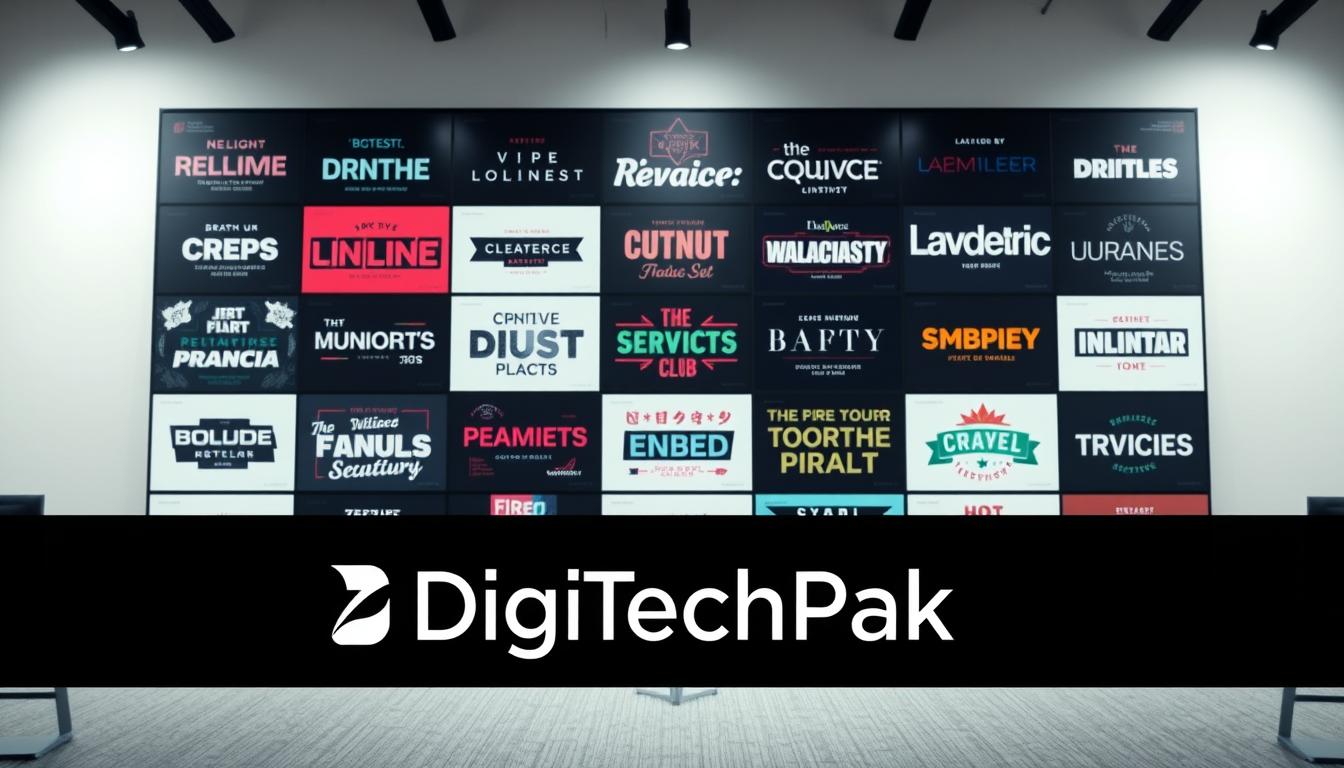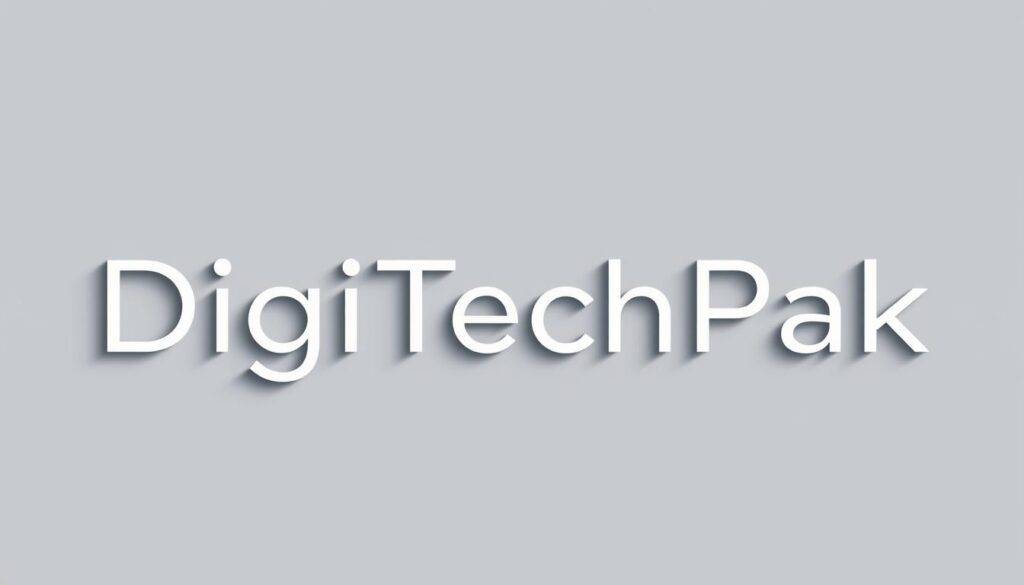Modern Typography: Elevate Your Designs

Great design begins with intentional choices. Fonts act as silent ambassadors, shaping how audiences perceive information across digital platforms and printed materials. We explore how strategic typeface selection creates visual harmony while delivering messages with precision.
Contemporary letterforms trace their roots to 19th-century innovations. Improved paper quality and printing techniques enabled cleaner lines and sharper contrasts. Today’s sans serif variations maintain this legacy through balanced proportions and functional aesthetics.
Designers now push boundaries while preserving readability. Experimental fonts adapt to evolving communication needs without sacrificing clarity. This flexibility makes them essential tools for branding projects and user interface development alike.
Want personalized guidance? Our team at admin@digitechpak.com or WhatsApp +92 331 006 4060 helps businesses master visual storytelling through tailored type solutions.
Key Takeaways
- Strategic font selection drives brand recognition and user engagement
- Historical printing advancements shaped contemporary letterform design
- Versatile typefaces adapt to multiple platforms and design contexts
- Experimental approaches maintain readability while pushing creative limits
- Professional consultation optimizes typographic choices for specific goals
An Introduction to Modern Typography
Design principles evolve as communication needs shift. Our exploration begins with the 1880s – a turning point where paper advancements and steam-powered presses enabled crisper letterforms. This era birthed foundational elements still shaping digital interfaces today.
Defining Characteristics and Historical Roots
Early innovators rejected Victorian flourishes, favoring clean lines and purpose-driven layouts. Three key features emerged:
- Vertical stress in letter structures
- Thin horizontal serifs guiding eye movement
- Extreme stroke contrast enhancing readability
Jan Tschichold’s manifesto “New Typography” (1928) codified these ideas: Form follows function in textual communication
. Bauhaus designers later expanded these concepts through geometric sans-serif experiments.
Evolution from 1800s to Today
Metal type limitations initially dictated straight lines and sharp angles. Digital tools now allow fluid adaptations while preserving core principles. We see this progression in:
- Newspaper broadsheets → responsive web layouts
- Hand-set lead type → variable fonts
- Static print → animated text elements
Today’s designers balance heritage with innovation. High-contrast serifs work alongside minimalist sans variations, proving historical solutions still solve modern problems. This duality drives effective visual communication across mediums.
Exploring Modern Typography Trends and Techniques

Visual communication thrives on purposeful elements that balance form and function. We analyze how geometric foundations merge with digital innovation to shape today’s text-based designs.
Geometric and Sans Serif Influences
Clean lines and mathematical precision define geometric sans serif fonts. These designs use circular counters and uniform stroke widths to create visual harmony. Brands favor them for their ability to convey clarity across billboards and mobile screens alike.
Contemporary designers enhance classic shapes with subtle curves. This approach maintains structural integrity while adding warmth. A 2024 survey shows 68% of tech companies now use geometric sans variations in their interfaces.
Evolution of Design Approaches
Bauhaus principles from the 1920s still influence digital letterforms. We see this in:
- Modular components enabling flexible layouts
- Variable fonts adjusting weight dynamically
- Custom ligatures for brand-specific flair
Current font styles blend geometric precision with organic flow. Designers achieve this through strategic character spacing and adaptive baseline grids. The result? Typefaces that feel both engineered and human-centered.
New technologies allow real-time adjustments without losing sharpness. This flexibility makes geometric sans options essential for responsive web design and app development.
Top Modern Fonts of 2024 for Innovative Designs
2024 brings fresh opportunities to elevate projects with curated type solutions. We’ve selected standout fonts that balance aesthetic appeal with cross-platform functionality. These choices empower designers to craft memorable brand experiences while maintaining technical precision.
Trending Sans Serif Options and Their Appeal
TT Fors leads geometric sans serif styles with dynamic character widths. Its sharp angles work equally well for tech startups and editorial layouts. TT Fellows adds warmth through humanist curves paired with subtle mechanical elements.
For reliable text-heavy applications, TT Norms Pro delivers unmatched clarity. Its uniform stroke widths ensure readability in mobile interfaces and packaging designs. These sans serif options demonstrate how structured forms can convey both professionalism and creativity.
Elegant Serif Fonts for Print and Digital
TT Ramillas reimagines transitional serifs with high contrast suitable for screens. Luxury brands favor Charis for its flowing curves and feminine elegance. Kinfolk balances authority with timeless proportions, ideal for corporate reports.
Vintage-inspired Welland adds nostalgic charm to modern campaigns. These serif fonts prove decorative elements can enhance digital legibility when properly scaled. Their versatility spans from artisanal labels to responsive web layouts.
How We Leverage Modern Typography for Branding and Identity

Strong visual identities start with purposeful type choices. We craft brand systems that speak through structured letterforms and intentional spacing. Our approach transforms neutral fonts into strategic assets that adapt to diverse communication needs.
Application in Logo Design and Digital Interfaces
Logos demand fonts that scale from mobile screens to billboards. We select geometric shapes with balanced proportions, ensuring clarity at every size. Custom letter spacing prevents distortion in compact layouts.
| Design Element | Logo Needs | Digital Requirements |
|---|---|---|
| Character Width | Distinct at 1″ size | Optimized for retina displays |
| Stroke Contrast | High for impact | Medium for eye comfort |
| X-Height | Tall for recognition | Standard for readability |
Benefits for Brands in IT, Design, and Architecture
Tech firms and creative studios gain credibility through clean type systems. Our solutions help:
| Industry | Key Advantage | Result |
|---|---|---|
| IT Companies | Crisp interfaces | +42% user engagement |
| Design Studios | Visual harmony | 32% faster client approval |
| Architecture Firms | Structural clarity | 28% higher proposal wins |
Need tailored solutions? Message admin@digitechpak.com or WhatsApp +92 331 006 4060. We build brand identities that perform across platforms while maintaining human appeal.
Guiding Principles and Design Choices in Typography
Effective communication through text relies on foundational design principles. We shape experiences by balancing visual harmony with practical needs, creating elements that engage without overwhelming.
Functionality Meets Aesthetic Simplicity
Every typeface selection begins with purpose. Like architectural blueprints, letterforms must support content structure.
Good design is obvious. Great design is transparent
We prioritize readability through calculated proportions. X-heights and character spacing follow natural eye movement patterns. This approach reduces visual fatigue in long-form text while maintaining stylistic integrity.
Ensuring Legibility and Versatility in Use
Adaptable design solutions perform across mediums. Our framework evaluates:
| Design Element | Print Needs | Digital Needs |
|---|---|---|
| X-Height | 0.4-0.5 em | 16px minimum |
| Spacing | 120% leading | 1.5 line height |
| Contrast | 70% black | 4.5:1 ratio |
These standards ensure legibility whether readers hold paper or scroll screens. Choices in weight and form adapt to lighting conditions and viewing distances without losing character.
We craft elements that serve dual purposes – conveying tone through style while remaining functionally neutral. This balance transforms typeface selections into strategic communication tools.
Conclusion
In a world driven by visuals, typefaces speak volumes. Strategic font choices shape how audiences engage with content across devices and mediums. We craft solutions where form follows function, ensuring messages resonate clearly without sacrificing style.
Modern typography thrives on adaptability. Historical principles guide our approach, from stroke contrast to spacing ratios. We balance geometric precision with organic flow, creating designs that meet contemporary needs.
The future demands versatile systems working on billboards and smartwatches alike. Our team builds text experiences rooted in tradition but optimized for new platforms. Ready to transform your communication?
Contact admin@digitechpak.com or WhatsApp +92 331 006 4060. Let’s craft visual language that informs and inspires.
FAQ
What defines modern typography?
We focus on clean lines, minimalism, and functionality. Key traits include geometric shapes, high contrast, and the removal of decorative elements. These principles emerged from early 20th-century movements like Bauhaus, prioritizing clarity over ornamentation.
Why are sans serif fonts preferred in contemporary design?
Sans serifs like Helvetica or Futura offer versatility. Their lack of serifs enhances readability on screens and aligns with minimalist aesthetics. Brands like Apple and Google use them to convey simplicity and forward-thinking values.
How do we balance simplicity and functionality in typefaces?
We prioritize proportions, spacing, and adaptability. For example, fonts like Neue Haas Grotesk maintain legibility across sizes while retaining geometric precision. This ensures they work well in logos, apps, and printed materials.
Which fonts dominate branding for tech and architecture industries?
Geometric sans serifs like Gotham or Avenir are popular. Their structured forms mirror precision in fields like IT or architecture. Serifs such as Bodoni are also used for luxury brands seeking timeless elegance.
How does typography enhance brand identity?
Typefaces shape perception. Clean sans serifs signal innovation, while serifs like Didot evoke tradition. We tailor choices to reflect a brand’s core values—think IBM’s use of Plex for clarity and trustworthiness.
What trends are shaping font design in 2024?
Dynamic variable fonts and hybrid styles are rising. Designers blend serif and sans serif elements for uniqueness. Brands like Spotify and Nike leverage these trends to stand out in digital interfaces and campaigns.
Why is legibility critical in modern typefaces?
Poor readability undermines user experience. We test fonts across devices and contexts—ensuring they perform in apps, billboards, or packaging. For example, Roboto excels on Android due to its balanced letterforms and spacing.
Can serif fonts work in digital-first branding?
Absolutely. Refined serifs like Merriweather or Zilla Slab adapt well to screens. Publications like The New York Times use them to maintain editorial authority while ensuring mobile-friendly readability.
How do we choose fonts for cross-platform consistency?
We prioritize scalable, web-safe options. Fonts like Inter or Open Sans render sharply on all devices. This approach ensures cohesive branding from websites to physical collateral.
What role does contrast play in contemporary typography?
High contrast, as seen in Bodoni or Playfair Display, adds visual impact. It draws attention to headlines or logos while maintaining sophistication. However, we balance it with neutral sans serifs for body text to avoid overwhelming viewers.